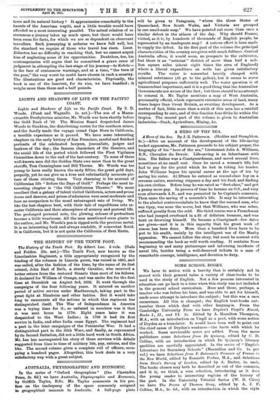AUSTRALIA, PHYSIOGRAPHIC AND ECONOMIC.
In the series of " Oxford Geographies " (the Clarendon Press, 3s. 6d.) we have Australia, Physiographic and Economic, by Griffith Taylor, B.Sc. Mr. Taylor comments in his pre- face on the inadequacy of the space commonly assigned in geographical manuals to Australia. A full-page plate will be given to Patagonia, " where the three States of Queensland, New South Wales, and Victoria are grouped in one small-scale map." We have pointed out more than once a similar defect in the atlases of the day. Why should France, visited, as it is, by hundreds of thousands of English people, be represented by an inadequate map P A serious effort is here made to supply the defect. In the first part of the volume the principal characteristics of the country are given with much fullness. Central Australia offers, it would seem, no prospects to the cultivator, but there is an "artesian" district of more than half a mil- lion square miles (about eight times the area of England) where a liberal expenditure on wells has given satisfactory results. The water is somewhat heavily charged with mineral substances (45 gr. to the gallon), but it seems to serve agricultural purposes sufficiently welL The water question is of transcendent importance, and it is a good thing that the Australian Governments are aware of the fact ; but there should be no attempt to conceal it. Mr. Taylor mentions a map of West Australia, presumably official, which represents extensive areas of land, many times larger than Great Britain, as awaiting development. As a matter of fact, little more than a sixth of this area has a rainfall corresponding to ours, and of this fraction four-fifths lie within the tropics. The second part of the volume is given to Australian industries—Stock, Agriculture, Mining, &c.


























































 Previous page
Previous page